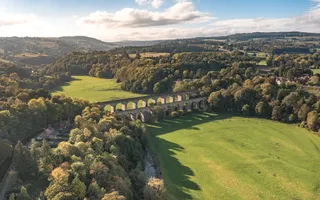We'd love to tell you more
Our newsletter is packed full of exciting updates and stories of how our charity keeps canals alive.
The charity making life better by water
Making life better by water
The Llangollen Canal crosses the border between England and Wales. Its combination of picturesque countryside and breath-taking engineering draws visitors from far and wide.
This 41-mile long canal spans our Northwest, West Midlands and Wales & Southwest regions, running from King's Bridge in Berwyn, to Hurleston Locks where it meets the Shropshire Union Canal.
The Llangollen takes you past the majestic Pontcysyllte Aqueduct, the tallest navigable aqueduct in Britain, which carries the canal over the River Dee. It's a masterpiece of engineering and an icon of the Industrial Revolution. In 2009 along with 11 miles of canal and its associated structures, the aqueduct was awarded World Heritage Site status.
There is no shortage of scenic walks along the Llangollen. A popular destination for walkers, boasting predominantly flat, accessible towpaths and features impressive aqueducts, tunnels, and scenic countryside views along the Welsh-English border.
Guide to canoeing the Pontcysyllte Aqueduct: Welsh version
The Llangollen Canal and its surrounding area has attracted visitors for 200 years. Visit Horseshoe Falls at Llantisillio or visit Chirk with its pairing of aqueduct and viaduct and short but surprisingly dark tunnel.
Apart from a few streams and field ditches draining into the canal, the water in the 46 miles of the Llangollen Canal comes almost entirely from the River Dee at Llantysilio at Horseshoe Falls. The section of canal west of Trevor was built as a 'navigable feeder' to supply water to the Llangollen Canal and others. It still supplies water to the northern section of the Montgomery Canal and to the Shropshire Union Canal.
The canal is also used as a conduit to transfer water from Llantysilio to Hurlston Reservoir and its junction with the Shropshire Union Canal. The reservoir water is treated by United Utilities to form part of their drinking water supply.
Our newsletter is packed full of exciting updates and stories of how our charity keeps canals alive.

Sign up to our newsletter and discover how we protect canals and help nature thrive


